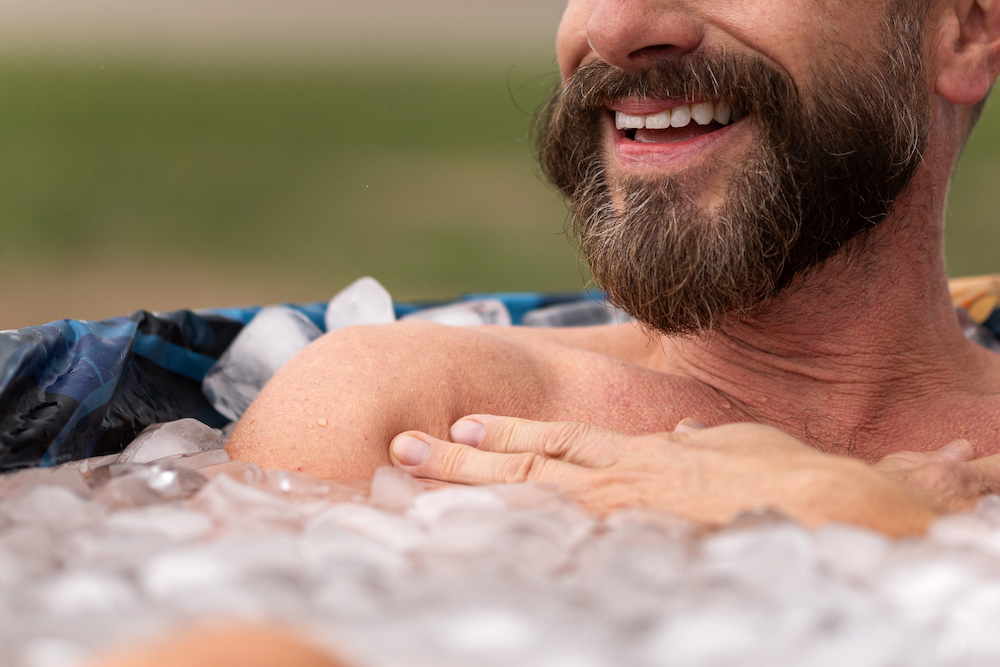Taking an ice bath can be a game-changer for recovery, helping reduce muscle soreness and inflammation after intense workouts. If you’re new to cold immersion, this science-based guide on how to ice bath is a great starting point. But if you’re wondering how much ice you actually need to create the perfect setup Too little, and you won’t feel the benefits; too much, and you risk making it unbearable.
The number of ice bags required depends on factors like the size of your tub, the water temperature, and your personal tolerance. Getting the balance right ensures your ice bath is both effective and comfortable. So, how do you determine the ideal amount of ice?

Benefits Of Ice Baths
Ice baths offer several advantages, particularly in athletic recovery and overall well-being.
- Reduce Muscle Soreness
Cold exposure reduces delayed onset muscle soreness (DOMS), which often occurs 24 to 48 hours after intense workouts. Immersing in an ice bath decreases tissue temperature, lowering inflammation and easing discomfort.
- Enhance Recovery
Submerging in cold water restricts blood flow temporarily; as blood vessels dilate post-bath, oxygen and nutrients flood the muscles. This process accelerates the repair of micro-tears caused by exercise.
- Lessen Inflammation
Cold immersion reduces swelling in overworked or injured areas. By decreasing metabolic activity and constricting blood vessels, it limits the spread of inflammatory substances.
- Boost Mental Resilience
With regular practice, ice baths strengthen mental toughness. Exposing yourself to cold discomfort builds discipline and can improve stress tolerance in everyday situations, as highlighted in this feature on mental clarity through daily habits.
- Improve Sleep Quality
Lowering your core body temperature promotes better sleep regulation. Post-ice bath relaxation may contribute to quicker and deeper sleep cycles. The Sleep Health Foundation’s insights highlight the crucial role of sleep in maintaining overall health and well-being.
- Support Circulation
The alternating constriction and dilation of blood vessels enhance blood flow. Improved circulation benefits cardiovascular health and overall recovery efficiency.
Use ice baths responsibly, staying within your comfort zone to experience safe and effective results.
Factors Affecting Ice Requirements
The amount of ice needed for an ice bath depends on multiple factors that influence its efficiency and comfort. Understanding these variables ensures optimal usage and benefits.
Size Of The Ice Bath
The volume of the tub determines how much ice is required. Larger tubs, such as outdoor troughs, typically need between 22–36 kg, while smaller bathtubs may require only 9–18 kg. Ensure the ice covers enough surface area to lower the water temperature effectively.
Duration Of The Ice Bath
Longer sessions demand more ice to maintain cold temperatures. For sessions lasting over 10–15 minutes, replenishing ice might be necessary to sustain effectiveness. Shorter baths usually retain their temperature without additional ice.
Ambient Temperature
The surrounding environment affects how quickly the ice melts. Warmer rooms demand more ice to maintain the desired temperature, while cold settings slow melting. Outdoor setups during summer typically require greater quantities than indoor baths in cooler seasons.
How Many Bags Of Ice Are Needed
You can determine the number of ice bags required for an ice bath by considering factors such as container size, water level, and temperature. Tailoring the amount of ice to your needs ensures the bath is both effective and comfortable.
Standard Recommendations
Use 9–18 kg of ice for smaller tubs and 22–36 kg for larger ones. This translates to 5–10 standard bags (1.8–2 kg per bag) for smaller setups and 12–20 bags for larger containers. Aim for a water temperature of 10–15°C for optimal results.
Adjustments For Personal Preferences
Add or reduce ice if you prefer a milder or colder experience. Gradual acclimation to colder temperatures over successive baths allows you to customise the experience further. Factor in your tolerance and duration to ensure a safe experience.
Estimating Based On Container Size
Estimate ice quantity based on the total volume of your container. For a compact bathtub holding 150–250 litres of water, 9–18 kg of ice suffices. Larger containers such as stock tanks may need 22–36 kg to achieve the desired chill.
Tips For Setting Up An Ice Bath
Setting up an ice bath effectively ensures you get the desired recovery benefits. Focus on key elements like the container, temperature, and ice management for an efficient setup.
Choosing The Right Container
Select a container based on the available space and volume needed. For home use, compact bathtubs or small inflatable tubs work well for limited water and ice requirements. Use larger stock tanks or portable cold tubs for group or longer sessions. Ensure the container is deep enough to submerge your lower body and parts of your upper body for maximum coverage.
Maintaining The Ideal Temperature
Keep the water temperature between 10–15°C for optimal recovery benefits. Use a thermometer to check accuracy, and adjust by adding ice or small amounts of warm water as needed. Start with 9–18 kg of ice for smaller containers and 22–36 kg for larger ones, depending on ambient temperature and session duration. Avoid temperatures below 10°C to minimise discomfort and potential harm.
Reusing And Storing Ice
Extend ice usage by reusing partially melted ice from previous sessions. Transfer leftover ice to an insulated cooler or freezer after draining excess water. When storing purchased ice bags, keep them in a freezer or shaded area before use to prevent premature melting. Investing in an ice machine can provide a cost-effective, long-term solution for frequent users.
Conclusion
Determining the right amount of ice for your ice bath depends on factors like tub size, session duration, and your personal preferences. By understanding these variables and aiming for the ideal temperature range of 10–15°C, you can create an effective and comfortable recovery experience.
Whether you’re using a small bathtub or a larger stock tank, adjusting the ice quantity ensures you get the most out of your session. With proper planning and setup, ice baths can become a valuable part of your recovery routine, promoting both physical and mental well-being.
Frequently Asked Questions
1. What are the main benefits of an ice bath?
Ice baths help reduce muscle soreness, inflammation, and delayed onset muscle soreness (DOMS). They enhance recovery by accelerating muscle repair, improving circulation, and easing swelling. Regular ice baths can also boost mental resilience, improve sleep quality, and regulate body temperature.
2. How much ice do I need for an effective ice bath?
The amount of ice depends on the size of the tub and desired temperature. Smaller tubs require 9–18 kg of ice, while larger tubs may need 22–36 kg. Aim for a water temperature of 10–15°C for optimal results.
3. How many ice bags should I use for an ice bath?
Use 5–10 bags (1.8–2 kg per bag) for smaller tubs and 12–20 bags for larger ones. Adjust based on personal preference and the tub size to maintain the ideal water temperature.
4. How long should I stay in an ice bath?
Typically, ice baths last 10–15 minutes. Staying within your comfort zone is key, as prolonged exposure may cause discomfort or potential harm. Always monitor your tolerance levels closely.
5. Can I reuse the ice from my ice bath?
Yes, partially melted ice can be reused by transferring it to an insulated cooler or freezer. This helps extend its usability for future ice baths and ensures effective temperature management.
6. How can I maintain the ideal ice bath temperature?
Regularly check the water temperature with a thermometer and adjust with more ice to maintain 10–15°C. Warmer environments may require more frequent additions of ice to sustain the chill.
7. What type of container is best for an ice bath?
Choose a container based on your needs and space. Compact bathtubs work well for home use, while larger stock tanks are suitable for group sessions or those needing more space.
8. What is the recommended frequency for taking ice baths?
Ice baths are best used 1–3 times per week, depending on your recovery needs and activity intensity. Overdoing it may limit benefits, so moderation is crucial.
9. Are ice baths safe for everyone?
Most people can safely use ice baths, but individuals with heart conditions, circulatory issues, or cold sensitivity should consult a medical professional first. Always listen to your body and start gradually.
10. Can ice baths improve sleep?
Yes, ice baths help regulate body temperature, promoting better sleep quality. The reduction in inflammation and relaxation benefits can also contribute to improved rest.










